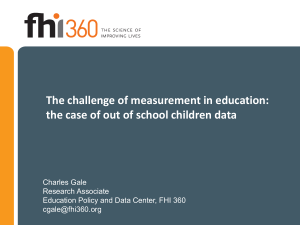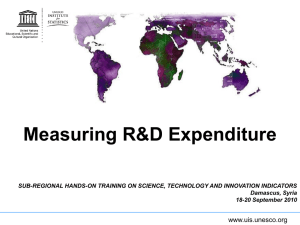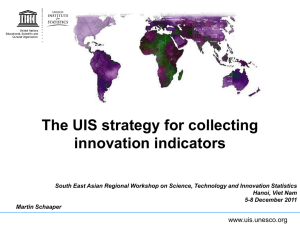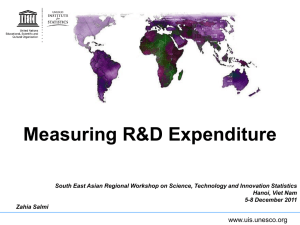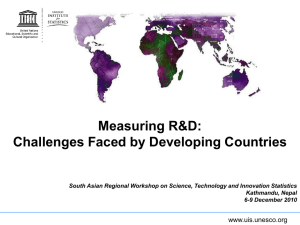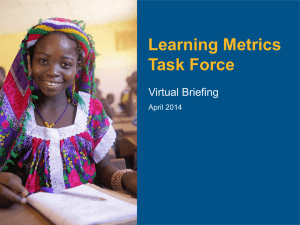UIS S&T Statistics workshops
advertisement
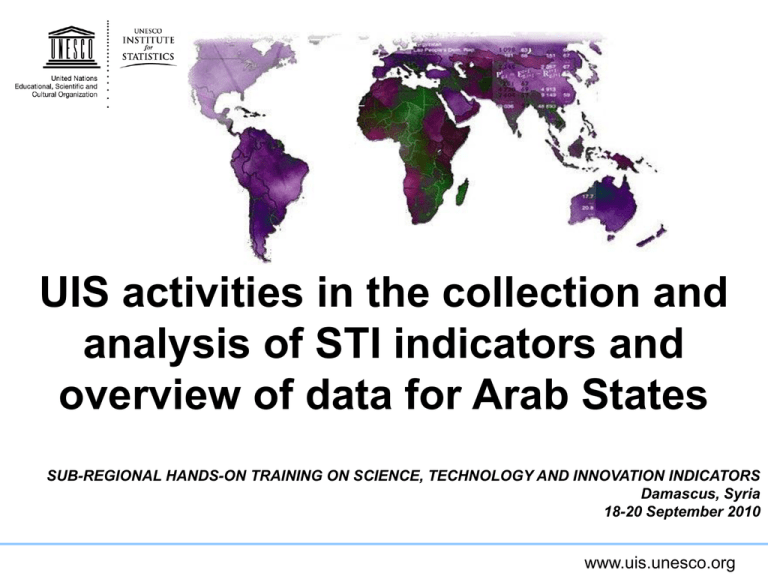
UIS activities in the collection and analysis of STI indicators and overview of data for Arab States SUB-REGIONAL HANDS-ON TRAINING ON SCIENCE, TECHNOLOGY AND INNOVATION INDICATORS Damascus, Syria 18-20 September 2010 www.uis.unesco.org Objectives of this presentation Present the work that UIS does to support the collection and analysis of STI indicators in developing countries Provide an overview of the availability of STI indicators worldwide and in the region www.uis.unesco.org UIS is the UN lead agency for S&T statistics Official S&T data source for: UN Statistical Division: UN Statistical Year Book UNDP: Human Development Report World Bank: World Development Indicators UNESCO Reports: • UNESCO Science Report • UNESCO World Report - Towards Knowledge Societies • International Report on S&T and Gender www.uis.unesco.org UIS Strategy on S&T statistics International Review of S&T Statistics & Indicators 2002-03 Resulting priorities: Immediate term: • R&D personnel & expenditure • Human resources devoted to S&T • Science education & Higher education • International mobility • Gender Medium term: Innovation data • Just started! Longer term: Output & Impact www.uis.unesco.org Lines of action 1. S&T survey operation and data guardianship 2. Training in S&T statistics: workshops & other training activities 3. Standard setting and methodological developments 4. Analysis and publications www.uis.unesco.org 1. S&T Survey operation and data guardianship Global survey on statistics of science & technology Global database on S&T Statistics Data dissemination: on the UIS website and through contributions to other agencies 2011: pilot survey of innovation data www.uis.unesco.org Survey on Statistics of Science & Technology Biennially. 2004, 2006 and 2008 S&T surveys completed. 4th round launched in June 2010. Results released on UIS website (http://stats.uis.unesco.org). OECD and Eurostat provide data for their Member States. RICYT provides data for Latin America. UIS keeps direct contact with national S&T statisticians. www.uis.unesco.org Data collection R&D Personnel By sector of employment, occupation, qualification, and field of science In headcount and FTE By gender R&D Expenditure By sector of performance and source of funds New: by type of activity and field of science www.uis.unesco.org UIS 2006 and 2008 Surveys on R&D: response rates & published data Responses Q 2006 Regions (Countries and Territories covered) Responses Q 2008 Sub-Saharan Africa (46) 27 59% Arab States-Africa (8) 6 75% Asia (31, excl. Arab States & OECD) 21 68% Arab States - Asia (12) 7 58% Americas (19, excl. RICYT & OECD) 4 21% 4 21% 4 21% Europe (16, excl. OECD & Eurostat) 9 56% 11 69% 10 63% Oceania (17, excl. OECD) 0 0% 4 24% 3 18% 74 50% 71 48% 78 52% 43 100% 19 83% 140 65% Sub-total (149) 61% 65% 21 46% 4 50% 21 68% 6 50% Published data 46% 63% 27 59% 6 75% 24 77% 4 33% 61% 65% Data from other sources: OECD + Eurostat (43) Total coverage Total coverage RICYT (23) Total (215) 140 65% 137 64% www.uis.unesco.org Respondents to the UIS S&T 2006-08-10 questionnaires from Arab States Country 2006 S&T Survey 2008 S&T Survey 2010 S&T Survey Algeria Data provided Data not provided Bahrain Data not provided Data not provided Djibouti Data not provided Data not provided Egypt Data not provided Data provided Received Iraq Data not provided Data provided Received Jordan Data provided Data not provided Received Kuwait Data provided Data provided Received Lebanon Data not provided Data not provided Libyan Arab Jamahiriya Data not provided Data provided Mauritania Data not provided Data not provided Partial response www.uis.unesco.org Respondents to the UIS S&T 2006-08-10 questionnaires from Arab States – cont’d Country 2006 S&T Survey 2008 S&T Survey Morocco Data provided Data provided Oman Data not provided Data not provided Palestinian Aut. Territories Data provided Data not provided Qatar Data not provided Data not provided Saudi Arabia Data not provided Data provided Sudan Data provided Data not provided Syrian Arab Republic Data not provided Data not provided Tunisia Data provided Data provided United Arab Emirates Data not provided Data not provided Yemen Data not provided Data not provided 2010 S&T survey Received Received Received Received www.uis.unesco.org Number of researchers worldwide 2002 2007 5,000 Researchers (in thousands) 4,478 4,500 4,047 4,000 3,500 3,000 2,731 2,500 2,000 1,763 1,500 1,000 500 Developed countries Source: UIS estimates, August 2010 Developing countries www.uis.unesco.org Which countries host the greatest number of researchers? Number of researchers, 2007 or latest available year 215,755 154,827 139,011 1,425,550 221,928 261,406 290,853 451,213 709,974 1,423,380 United States -1 China Japan Russian Fed. +1 Germany United Kingdom +1 Rep. of Korea France India -2 Canada -1 Source: UIS, August 2010 Note: +1 = 2008, -1 = 2006, -2 = 2005. Data in this graph are based www.uis.unesco.org on FTE data. What are the national research densities? Researchers per million inhabitants, 2007 or latest available year 0–100 per million 101–300 per million 301–1000 per million 1001–2000 per million 2001 per million and above Data not available Source: UIS, August 2010 Note: Data in this map are based on FTE. However, figures in headcounts (HC) were considered for the following countries since the FTE figures were not available: Armenia; Azerbaijan; Bangladesh; Belarus; Benin; Botswana; Burkina Faso; Cameroon; Central African Rep.; Cuba; Dem. Rep. of the Congo; El Salvador; Gabon; Gambia; Georgia; Guinea; Honduras; Jordan; Kazakhstan; Kyrgyzstan; Libya; Mauritius; Mongolia; Montenegro; Nauru; Nicaragua; Nigeria; Peru; Saint Lucia; Saint Vincent and the Grenadines; Saudi Arabia; Sudan; Tajikistan; Trinidad and Tobago; Uganda; U.S. Virgin Islands; and Zambia. This has to be taken into account when interpreting the data. www.uis.unesco.org The gender gap in science. Women as a share of total researchers, 2007 or latest available year 0%–30% 30.1%–45% 45.1%–55% 55.1%–70% 70.1%–100% Data not available Source: UIS, August 2010 Note: Data in this map are based on HC, except for Congo and www.uis.unesco.org India (based on FTE). R&D Personnel, Arab countries, 2007 or last available year Country Algeria Year 2005* Researchers per million inhabitants (FTE) Researchers (FTE) 5,593 170 Bahrain … … … Djibouti … … … 49,363 617 … … 15,891 3,030 472 166 … … 373 60 … … 19,972 647 Egypt 2007 … Iraq Jordan 2003* (HC) Kuwait 2007* … Lebanon 2007* (HC) Libyan Arab Jamahiriya … Mauritania Morocco 2006* Source: UIS S&T Database, 2009. FTE: Full-time equivalents, HC: Head count instead of Full-time equivalent, * Based on partial data www.uis.unesco.org R&D Personnel, Arab countries, 2007 or last available year Country Year Researchers per million inhabitants (FTE) Researchers (FTE) Oman … … … Palestinian Autonomous Territories … … … Qatar … … … Saudi Arabia 2007* (HC) 1,024 41 Sudan 2005 (HC) 11,208 290 … … 15,833 1,588 … Syrian Arab Republic Tunisia 2006 United Arab Emirates … … … Yemen … … … Source: UIS S&T Database, 2009. FTE: Full-time equivalents, HC: Head count instead of Full-time equivalent, * Based on partial data www.uis.unesco.org Researchers per million inhabitants, 2005 or latest available year – Arab States 0–100 per million 101–300 per million 301–1000 per million 1001–2000 per million 2001 per million and above Data not available Source: UIS, September 2007 www.uis.unesco.org Gross domestic expenditure on R&D (GERD) worldwide 2002 2007 1,000 873 GERD (in billions PPP$) 900 800 700 653 600 500 400 273 300 200 137 100 Developed countries Source: UIS estimates, August 2010 Developing countries www.uis.unesco.org GERD by region GERD in billions PPP$ by regions 450 400 350 300 250 200 150 100 50 0 1990 Americas 2002 Europe Africa 2007 Asia Oceania www.uis.unesco.org World’s top 10 leaders in R&D investment GERD (‘000 PPP$), 2007 or latest available year 23,961,471 24,792,602 23,382,745 398,086,000 41,043,072 41,339,086 42,892,759 72,241,917 102,428,349 147,938,883 United States +1 Japan China Germany France +1 Rep. of Korea United Kingdom +1 India Canada +1 Russian Fed. +1 Source: UIS, August 2010 Note: +1 = 2008. www.uis.unesco.org A snap-shot of R&D intensity. Gross domestic expenditure on R&D (GERD) as a percentage of GDP, 2007 or latest available year 0.00%–0.25% 0.26%–0.50% 0.51%–1.00% 1.01%–2.00% 2.01% and above Data not available Source: UIS, August 2010 www.uis.unesco.org Gross Domestic Expenditure on R&D (GERD) indicators in Arab States, 2007 or latest available year Year GERD (millions) – Local currency GERD PPP$ (millions) GERD – as % of GDP GERD per inhabitant (PPP$) Algeria 2005* 4,994 157 0.07% 4.8 Egypt 2007* 1,680 911 0.23% 11.4 Kuwait 2007* 28 110 0.09% 38.7 Morocco 2006* 3,670 765 0.64% 25.0 Saudi Arabia 2007* 705 271 0.05% 11.0 Sudan 2005 193 179 0.29% 4.6 Tunisia 2005 384 661 1.02% 66.9 Country Source: UIS S&T Database, 2009 * Based on partial data www.uis.unesco.org GERD as a percentage of GDP, 2005 or latest available year - Arab States 0.00%–0.25% 0.26%–0.50% 0.51%–1.00% 1.01%–2.00% 2.01% and above Data not available Source: UIS, September 2007 www.uis.unesco.org A breakdown of R&D investment in the Americas. GERD by sector of performance, 2007 or latest available year Business enterprise Government Private non-profit Unknown Higher education 100% 90% 80% 70% 60% 50% 40% 30% 20% 10% Source: UIS, August 2010 Note: +1 = 2008, -1 = 2006, -2 = 2005, -3 = 2004, -5 = 2002. Paraguay -2 Panama -2 Guatemala Uruguay +1 Ecuador Colombia Bolivia -5 Trinidad & Tobago -1 Peru -3 Argentina Costa Rica Brazil -3 Chile -3 Mexico Canada +1 United States +1 0% www.uis.unesco.org Source: UIS, August 2010 Note: +1 = 2008, -1 = 2006, -3 = 2004. www.uis.unesco.org Bosnia & Herzegovina Serbia Montenegro Macedonia (FYR) -1 Rep. of Moldova Cyprus +1 Lithuania +1 Latvia +1 Greece Private non-profit Romania +1 Poland +1 Bulgaria +1 Turkey Slovakia +1 Estonia +1 Croatia +1 Higher education Portugal +1 Hungary Italy +1 Norway +1 Iceland +1 Spain +1 Government Netherlands +1 Ukraine Belarus Czech Rep. +1 Russian Fed. +1 Business enterprise France +1 United Kingdom +1 Slovenia +1 Ireland +1 Malta +1 Belgium +1 Germany Denmark +1 Austria Finland +1 Switzerland -3 Sweden +1 Luxembourg +1 A breakdown of R&D investment in Europe. GERD by sector of performance, 2007 or latest available year 100% Unknown 90% 80% 70% 60% 50% 40% 30% 20% 10% 0% Source: UIS, August 2010 0% Note: +1 = 2008, -1 = 2006, -2 = 2005, -3 = 2004, -5 = 2002. www.uis.unesco.org New Zealand Australia -1 Georgia -2 Pakistan Brunei -3 Tajikistan -2 Armenia Mongolia Private non-profit Indonesia -2 Cambodia -5 Iran -1 Viet Nam -5 Sri Lanka -1 Azerbaijan Kyrgyzstan Higher education India Lao PDR -5 Thailand -2 Kazakhstan +1 Hong Kong -1 Philippines -2 Singapore Government China Rep. of Korea Japan Israel +1 Business enterprise Malaysia -1 Senegal -2 Madagascar Burkina Faso Ethiopia Seychelles -2 Uganda Zambia -2 Tunisia -2 Botswana -2 Morocco -1 Sudan -2 South Africa A breakdown of R&D investment in Africa, Asia and the Pacific. GERD by sector of performance, 2007 or latest available year 100% Unknown 90% 80% 70% 60% 50% 40% 30% 20% 10% A breakdown of researchers in the Americas. Researchers by sector of employment, 2007 or latest available year Business enterprise Government Private non-profit Unknown Higher education 100% 90% 80% 70% 60% 50% 40% 30% 20% 10% Source: UIS, August 2010 Nicaragua* -3 Paraguay -2 Costa Rica* Panama Guatemala Colombia Trinidad & Tobago* Venezuela +1 Uruguay +1 El Salvador* +1 Bolivia -5 Argentina Honduras* -4 Ecuador* Brazil +1 Mexico Chile -3 Canada -1 United States -1 0% Note: +1 = 2008, -1 = 2006, -2 = 2005, -3 = 2004, -4 = 2003, -5 = 2002. Data in this graph www.uis.unesco.org are based on FTE data (* based on HC data). Source: UIS, August 2010 Serbia Montenegro* Macedonia (FYR) -1 Latvia +1 Slovakia +1 Bulgaria +1 Lithuania +1 Rep. of Moldova Poland +1 Private non-profit Croatia +1 Cyprus +1 Portugal +1 Greece Turkey Estonia +1 Higher education Romania +1 Spain +1 United Kingdom +1 Italy +1 Hungary Ukraine Government Slovenia +1 Czech Rep. +1 Belarus* Malta +1 Iceland +1 Business enterprise Belgium +1 Switzerland -3 Russian Fed. +1 Norway +1 Netherlands +1 Ireland +1 France Finland +1 Germany Austria +1 Denmark +1 Luxembourg +1 Sweden +1 A breakdown of researchers in Europe. Researchers by sector of employment, 2007 or latest available year 100% Unknown 90% 80% 70% 60% 50% 40% 30% 20% 10% 0% Note: +1 = 2008, -1 = 2006, -3 = 2004. Data in this graph are based on FTE data (* based on www.uis.unesco.org HC data). Source: UIS, August 2010 Government Higher education Private non-profit Australia -1 New Zealand Business enterprise Rep. of Korea Japan China Singapore Hong Kong -1 Philippines -2 India -2 Malaysia -1 Jordan* -4 Lao PDR -5 Kazakhstan* +1 Thailand -2 Kyrgyzstan* Brunei -4 Azerbaijan* Iran -1 Cambodia -5 Sri Lanka -1 Viet Nam -5 Mongolia* Indonesia -6 Armenia* Tajikistan* -1 Bangladesh* Georgia* -2 Pakistan Macao, China -2 South Africa Morocco -1 Botswana* -2 Uganda* Sudan* -2 Zambia* -2 Burkina Faso* Ethiopia Seychelles -2 Egypt Lesotho -3 Guinea* -7 Mali -1 Madagascar Algeria -2 Senegal Togo Tunisia -1 Congo DR* -2 Nigeria* -2 Côte d'Ivoire -2 A breakdown of researchers in Africa, Asia and the Pacific. Researchers by sector of employment, 2007 or latest available year 100% Unknown 90% 80% 70% 60% 50% 40% 30% 20% 10% 0% Note: +1 = 2008, -1 = 2006, -2 = 2005, -3 = 2004, -4 = 2003, -5 = 2002, -6 = 2001, -7 = 2000, - 10 www.uis.unesco.org = 1997. Data in this graph are based on FTE data (* based on HC data). Funding in the Americas. GERD by source of funds, 2007 or latest available year Business enterprise Government Higher education Private non-profit Abroad Unknown 100% 90% 80% 70% 60% 50% 40% 30% 20% 10% Source: UIS, August 2010 Notes: +1 = 2008, -2 = 2005, -3 = 2004, -5 = 2002. Guatemala Paraguay -2 Panama -2 El Salvador Bolivia -5 Cuba +1 Ecuador Uruguay +1 Colombia Argentina Brazil Mexico Chile -3 Canada +1 United States +1 0% www.uis.unesco.org Source: UIS, August 2010 Note: +1 = 2008, -2 = 2005, -3 = 2004, -4 = 2003, -5 = 2002 www.uis.unesco.org Rep. of Moldova Macedonia (FYR) -5 Cyprus Lithuania +1 Abroad Romania +1 Latvia +1 Russian Fed. +1 Ukraine Private non-profit Poland +1 Greece -2 Estonia +1 Bulgaria Slovakia +1 Croatia +1 Higher education Italy Hungary Belarus Norway Spain Austria +1 Government Portugal United Kingdom +1 Turkey Ireland Iceland +1 Business enterprise France +1 Malta +1 Netherlands -4 Czech Rep. +1 Denmark +1 Belgium Slovenia +1 Sweden Germany Finland Switzerland -3 Luxembourg Funding in Europe. GERD by source of funds, 2007 or latest available year Unknown 100% 90% 80% 70% 60% 50% 40% 30% 20% 10% 0% Source: UIS, August 2010 Note: +1 = 2008, -1 = 2006, -2 = 2005, -3 = 2004, -5 = 2002, -6 www.uis.unesco.org = 2001. New Zealand Australia -1 Cambodia -5 Armenia Abroad Pakistan Brunei -3 Tajikistan -2 Kuwait Private non-profit Mongolia Iran -1 Indonesia -6 Viet Nam -5 Sri Lanka -1 Azerbaijan Higher education India Lao PDR -5 Kyrgyzstan -2 Thailand -2 Kazakhstan +1 Hong Kong -1 Government Singapore Philippines -2 China Rep. of Korea Israel -1 Business enterprise Japan Malaysia -1 Mozambique -5 Madagascar Ethiopia Burkina Faso Uganda Tunisia -2 Morocco -1 South Africa -1 Funding in Africa, Asia and the Pacific. GERD by source of funds, 2007 or latest available year 100% Unknown 90% 80% 70% 60% 50% 40% 30% 20% 10% 0% Quality of data Efficient use of resources Consistency over time and space Accessibility and affordability Validity and reliability Relevance to policy Potential for disaggregation Comparability through standards Clarity and transparency Currency and punctuality Coherence across sources www.uis.unesco.org 2. Capacity building There are many problems: Lack of understanding of importance of S&T (indicators) Lack of political will and action Lack of coordination Lack of trained personnel High staff turnover www.uis.unesco.org Capacity building (2) Measurement problems: Measuring “real effort” (full-time equivalents) Private sector R&D Budget data vs. surveys Role of foreign entities www.uis.unesco.org S&T statistics workshops Increase the number of countries regularly producing quality S&T indicators. Create local capacities and establish sustainable local S&T statistics systems. Promote the use of S&T indicators for evidence-based S&T policy making. Share experiences with other developing countries and address problems. Gain knowledge about the particular characteristics of S&T statistics data. Demonstrate good practices in other countries of the region. www.uis.unesco.org UIS S&T Statistics workshops 2005: Uganda, India 2006: Indonesia, Senegal, Kazakhstan 2007: Tunisia, FYR of Macedonia, Jordan, Brazil, Russia, Cameroon 2008: Oman, Cambodia, Botswana 2009: Kenya, Egypt 2010: Mali, Syria, Uzbekistan, Nepal But also contributing to similar workshops of partner organisations (e.g. RICYT, NEPAD) www.uis.unesco.org Countries that have participated in UNESCO S&T statistics workshops 2005-2009 Countries and territories covered Countries and territories covered but absent Countries and territories not yet covered Countries and territories not targeted www.uis.unesco.org Results of workshops Increased response rate – non-responding countries learn how to do it from UIS and neighbours. Immediate problems solved. Increased data quality – improved understanding of application of international standards. Face to face contacts = more effective networking. Inputs to UIS programme development. www.uis.unesco.org 3. Standard setting/methodological developments Careers of Doctoral Holders – CDH (since 2004) Measuring Innovation in Developing countries: Annex to the Oslo Manual (2005) • Will be presented separately Measuring R&D in Developing Countries: Technical Guide and Annex to the Frascati Manual (2010) • Will be presented separately www.uis.unesco.org The careers of doctorate holders survey (CDH) A joint project with the OECD and Eurostat. Methodology developed “from scratch”. Aimed both at developed and developing countries. With participation from experts from both developed and developing countries. Promoting the methodology by encouraging developing countries to conduct such surveys and produce cross-nationally comparable statistics on careers of doctorate holders. www.uis.unesco.org Relevance of the CDH project Focus on the crucial role of highly qualified individuals who represent a key to the production, application and transmission of knowledge. Statistics on the global trends in human resources for Science and Technology (HRST) very weak. Quality and comparability of international data on migration is particularly weak. Diversity of data collection methods hinders international comparability, and does not provide information on career paths and mobility patterns. www.uis.unesco.org Objectives of CDH Objectives: To design an internationally comparable tool for tracking the careers of doctorates holders and highly qualified people in different countries. To collect and exchange information on the career paths of holders of doctorates from existing data sources and the new survey tool. www.uis.unesco.org CDH toolkit Components: Model questionnaire and Instruction Manual Output tables and variables definitions Methodological guidelines Bridge table model questionnaire - output tables See: http://www.uis.unesco.org/ev.php?URL_ID=5219& URL_DO=DO_TOPIC&URL_SECTION=201 and www.oecd.org/sti/cdh www.uis.unesco.org CDH modules Doctoral Education (EDU) Early Career Research positions (ECR) Employment situation (EMP) International mobility (MOB) Career-related experience (CAR) Personal characteristics (PER) www.uis.unesco.org 4. Some publications Data publicly available at: www.uis.unesco.org UIS Publications (can be downloaded from the UIS website): • S&T Bulletin 1 – Investment in R&D; • S&T Bulletin 2 – Bibliometric Indicators; • S&T Bulletin 3 – Women in Science • Fact sheet: R&D statistics (recently updated) UNESCO Science Report 2010 (out in November) International Report on Science, Technology and Gender 2007 UNESCO World Report History of Science Statistics at UNESCO Paper on ‘current status of International Science statistics for Africa’ in African Statistical Journal www.uis.unesco.org Collaborations / Partnerships UNESCO HQs UNESCO offices worldwide World Bank OECD Eurostat RICYT (Latin America) AU-NEPAD ALECSO ADB Arab Academy of Science ATPS ISESCO ISDB Inter-Academy Council EU-Medibtikar INRS (Quebec, Canada) IDRC (Canada) ASEAN IRD (France) www.uis.unesco.org Way forward There is still a lot to do! UIS needs to keep direct contact with statisticians: Quality and relevance. Countries to establish sustainable S&T statistics systems, involving line ministries (S&T Ministries or Research Councils) and National Statistical Offices. Looking forward to further cooperation. www.uis.unesco.org Thank you! http://www.uis.unesco.org m.schaaper@uis.unesco.org www.uis.unesco.org
